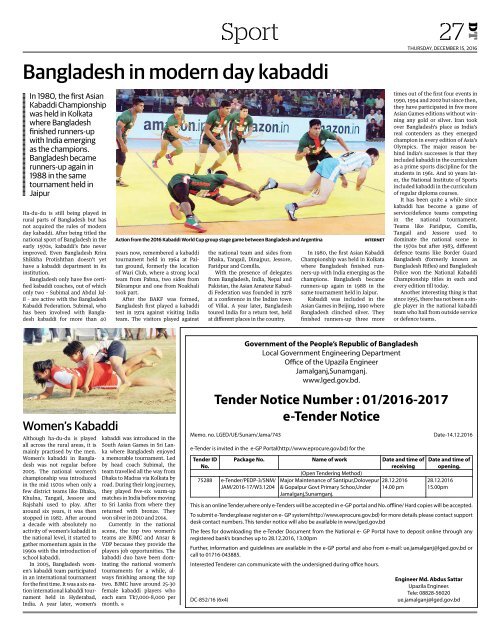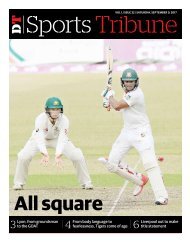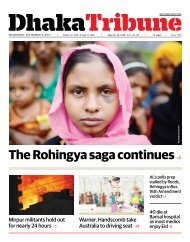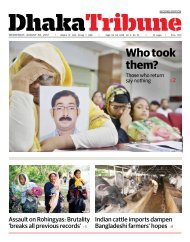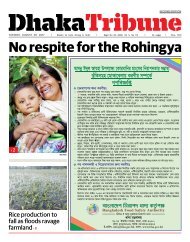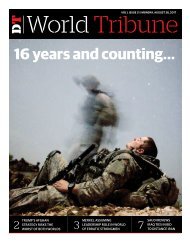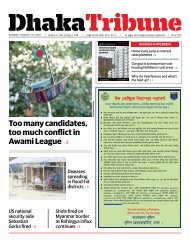DT e-Paper, Thursday, December 15, 2016
Create successful ePaper yourself
Turn your PDF publications into a flip-book with our unique Google optimized e-Paper software.
Bangladesh in modern day kabaddi<br />
Sport 27<br />
<strong>DT</strong><br />
THURSDAY, DECEMBER <strong>15</strong>, <strong>2016</strong><br />
In 1980, the first Asian<br />
Kabaddi Championship<br />
was held in Kolkata<br />
where Bangladesh<br />
finished runners-up<br />
with India emerging<br />
as the champions.<br />
Bangladesh became<br />
runners-up again in<br />
1988 in the same<br />
tournament held in<br />
Jaipur<br />
Ha-du-du is still being played in<br />
rural parts of Bangladesh but has<br />
not acquired the rules of modern<br />
day kabaddi. After being titled the<br />
national sport of Bangladesh in the<br />
early 1970s, kabaddi’s fate never<br />
improved. Even Bangladesh Krira<br />
Shikkha Protishthan doesn’t yet<br />
have a kabaddi department in its<br />
institution.<br />
Bangladesh only have five certified<br />
kabaddi coaches, out of which<br />
only two – Subimal and Abdul Jalil<br />
– are active with the Bangladesh<br />
Kabaddi Federation. Subimal, who<br />
has been involved with Bangladesh<br />
kabaddi for more than 40<br />
Action from the <strong>2016</strong> Kabaddi World Cup group stage game between Bangladesh and Argentina<br />
years now, remembered a kabaddi<br />
tournament held in 1964 at Paltan<br />
ground, formerly the location<br />
of Wari Club, where a strong local<br />
team from Pabna, two sides from<br />
Bikrampur and one from Noakhali<br />
took part.<br />
After the BAKF was formed,<br />
Bangladesh first played a kabaddi<br />
test in 1974 against visiting India<br />
team. The visitors played against<br />
the national team and sides from<br />
Dhaka, Tangail, Dinajpur, Jessore,<br />
Faridpur and Comilla.<br />
With the presence of delegates<br />
from Bangladesh, India, Nepal and<br />
Pakistan, the Asian Amateur Kabaddi<br />
Federation was founded in 1978<br />
at a conference in the Indian town<br />
of Villai. A year later, Bangladesh<br />
toured India for a return test, held<br />
at different places in the country.<br />
INTERNET<br />
In 1980, the first Asian Kabaddi<br />
Championship was held in Kolkata<br />
where Bangladesh finished runners-up<br />
with India emerging as the<br />
champions. Bangladesh became<br />
runners-up again in 1988 in the<br />
same tournament held in Jaipur.<br />
Kabaddi was included in the<br />
Asian Games in Beijing, 1990 where<br />
Bangladesh clinched silver. They<br />
finished runners-up three more<br />
times out of the first four events in<br />
1990, 1994 and 2002 but since then,<br />
they have participated in five more<br />
Asian Games editions without winning<br />
any gold or silver. Iran took<br />
over Bangladesh’s place as India’s<br />
real contenders as they emerged<br />
champion in every edition of Asia’s<br />
Olympics. The major reason behind<br />
India’s successes is that they<br />
included kabaddi in the curriculum<br />
as a prime sports discipline for the<br />
students in 1961. And 10 years later,<br />
the National Institute of Sports<br />
included kabaddi in the curriculum<br />
of regular diploma courses.<br />
It has been quite a while since<br />
kabaddi has become a game of<br />
service/defence teams competing<br />
in the national tournament.<br />
Teams like Faridpur, Comilla,<br />
Tangail and Jessore used to<br />
dominate the national scene in<br />
the 1970s but after 1983, different<br />
defence teams like Border Guard<br />
Bangladesh (formerly known as<br />
Bangladesh Rifles) and Bangladesh<br />
Police won the National Kabaddi<br />
Championship titles in each and<br />
every edition till today.<br />
Another interesting thing is that<br />
since 1995, there has not been a single<br />
player in the national kabaddi<br />
team who hail from outside service<br />
or defence teams.<br />
Women’s Kabaddi<br />
Although ha-du-du is played<br />
all across the rural areas, it is<br />
mainly practised by the men.<br />
Women’s kabaddi in Bangladesh<br />
was not regular before<br />
2005. The national women’s<br />
championship was introduced<br />
in the mid 1970s when only a<br />
few district teams like Dhaka,<br />
Khulna, Tangail, Jessore and<br />
Rajshahi used to play. After<br />
around six years, it was then<br />
stopped in 1982. After around<br />
a decade with absolutely no<br />
activity of women’s kabaddi in<br />
the national level, it started to<br />
gather momentum again in the<br />
1990s with the introduction of<br />
school kabaddi.<br />
In 2005, Bangladesh women’s<br />
kabaddi team participated<br />
in an international tournament<br />
for the first time. It was a six-nation<br />
international kabaddi tournament<br />
held in Hyderabad,<br />
India. A year later, women’s<br />
kabaddi was introduced in the<br />
South Asian Games in Sri Lanka<br />
where Bangladesh enjoyed<br />
a memorable tournament. Led<br />
by head coach Subimal, the<br />
team travelled all the way from<br />
Dhaka to Madras via Kolkata by<br />
road. During their long journey,<br />
they played five-six warm-up<br />
matches in India before moving<br />
to Sri Lanka from where they<br />
returned with bronze. They<br />
won silver in 2010 and 2014.<br />
Currently in the national<br />
scene, the top two women’s<br />
teams are BJMC and Ansar &<br />
VDP because they provide the<br />
players job opportunities. The<br />
kabaddi duo have been dominating<br />
the national women’s<br />
tournaments for a while, always<br />
finishing among the top<br />
two. BJMC have around 25-30<br />
female kabaddi players who<br />
each earn Tk7,000-8,000 per<br />
month. •


